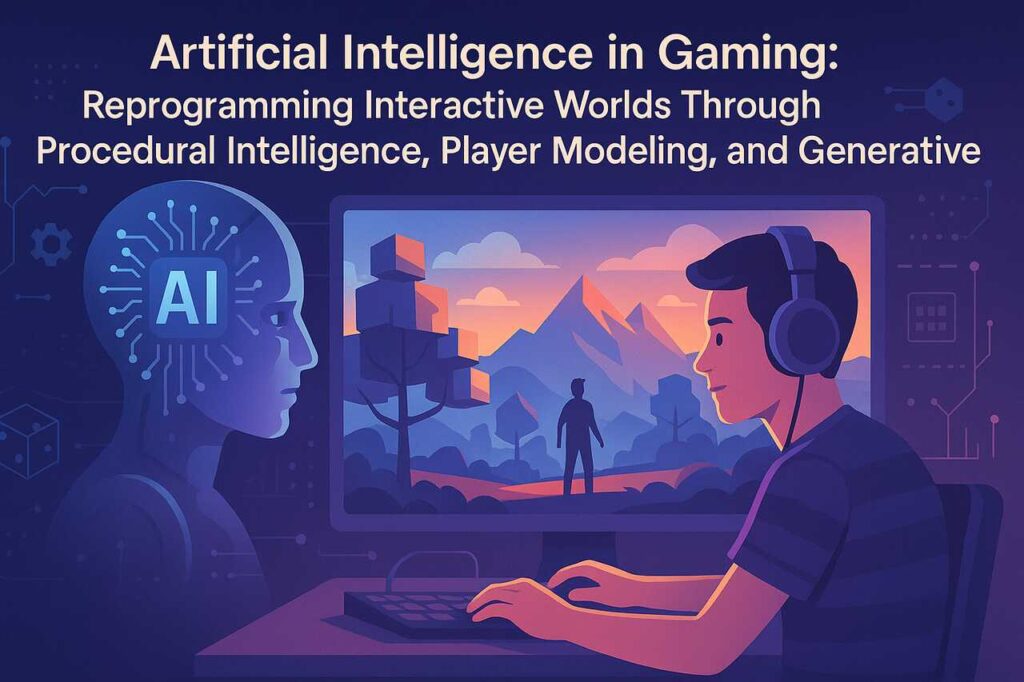How Is Artificial Intelligence Reshaping the Core Mechanics of Game Development?
Artificial Intelligence transforms traditional game development pipelines by automating procedural content generation, enhancing NPC behavior realism, and adapting game environments through real-time player interaction modeling. Game engines now integrate AI modules that dynamically modify level design, story arcs, and gameplay difficulty based on inferred player preferences and actions.
What Role Does Procedural Intelligence Play in Game Design?
Procedural Intelligence automates asset generation, terrain creation, and environmental structuring using rule-based and machine learning models. AI systems analyze gameplay context to generate content that aligns with narrative objectives, ensuring replayability and scalability without manual asset design.
How Are AI Models Enhancing Non-Playable Character (NPC) Behavior?
NPCs now utilize natural language processing, behavioral prediction models, and emotional simulation frameworks. These models simulate human-like responses and decision-making, enabling emergent storytelling where player-NPC interactions unfold in personalized, unscripted directions based on context and emotional cues.
How Is AI Impacting Game Narrative and Storytelling?
Narrative engines use language models to generate branching dialogue, quest lines, and reactive story elements. AI-driven story systems integrate player choices with ontological narrative structures, ensuring that plot developments align with player behavior and evolve dynamically, rather than through pre-written paths.
What Is the Role of AI in Game Testing and Optimization?
AI performs automated playtesting by simulating thousands of playthroughs using reinforcement learning agents. These agents expose bugs, balancing issues, and usability bottlenecks. Game performance metrics like frame rate variance, input latency, and interaction hotspots are continuously optimized via adaptive AI feedback loops.
How Is Player Modeling Revolutionizing Personalized Game Experiences?
Player modeling leverages real-time telemetry, psychographic profiling, and machine learning classifiers to infer player intent, skill level, and emotional state. These insights fuel personalized adjustments in difficulty, narrative tone, and game mechanics.
How Does AI Identify and Classify Player Behavior?
Classification models process user input patterns, movement heatmaps, and decision trees to assign behavioral archetypes (e.g., explorer, achiever, strategist). These models train on player cohorts, refining predictions about future in-game behavior and preferred interaction modalities.
How Do Games Use AI to Adapt in Real Time?
Dynamic difficulty adjustment (DDA) systems analyze in-game success rates, reaction times, and frustration markers (like repeated failure zones). Based on these inputs, AI modifies enemy intelligence, environmental hazards, and reward structures in real time to balance challenge with engagement.
How Is Emotional AI Used in Gaming?
Emotional inference engines process biometric data (e.g., heart rate, facial recognition) and behavioral indicators to detect emotional states. Games then respond by altering music, lighting, pacing, and dialogue creating affective gaming experiences that align with the player’s psychological state.
How Do Multiplayer Games Use AI for Matchmaking?
AI models evaluate skill ratings, historical behavior patterns, and player toxicity profiles using multi-factor ranking systems. These models ensure competitive balance, prevent griefing, and create harmonious matches by predicting interpersonal compatibility and in-game synergy.
What Role Do Generative Models Play in the Evolution of Game Design?
Generative AI models such as GANs, VAEs, and diffusion models are now used to co-create visual assets, game soundtracks, and dialogue systems. These models streamline creative processes while enhancing aesthetic diversity and narrative originality.
How Is Generative AI Used for Visual Asset Creation?
AI-powered art generation tools like Midjourney, Stable Diffusion, and Adobe Firefly create textures, characters, and environments. Developers feed these models style parameters, narrative context, and reference samples to generate visually coherent assets that match a game’s artistic direction.
How Are Game Studios Using AI for Music and Sound Design?
Generative audio models synthesize adaptive soundtracks and ambient effects that react to game states and player behavior. Tools like AIVA and Google’s MusicLM compose background music that dynamically shifts based on emotional tone, environmental context, and in-game tension.
Can AI Generate In-Game Dialogue That Feels Authentic?
Language models like ChatGPT, Inworld AI, and Charisma AI enable context-aware dialogue generation for NPCs. These models understand narrative arcs, past interactions, and emotional subtext, resulting in interactive conversations that reflect human-like responsiveness and memory.
How Are Developers Using AI to Co-Create Levels?
Generative level design tools use constraint-based generation and semantic tagging to produce modular levels. Developers input rulesets (e.g., pacing, difficulty scaling, narrative tension), and AI creates structurally sound environments that meet both gameplay and storytelling requirements.
What Are the Broader Implications of AI-Driven Games on Industry and Culture?
AI integration in gaming redefines both the economics of development and the sociocultural dynamics of play by democratizing creativity, enabling inclusive storytelling, and fostering user-generated content ecosystems.
How Does AI Reduce Game Development Costs?
AI automates content generation, QA testing, and user research, reducing reliance on large design teams. This lowers production costs and accelerates development timelines, enabling indie developers to compete with AAA studios by accessing the same generative infrastructure.
What Opportunities Does AI Open for User-Generated Content?
Players can now co-create in-game assets, mods, and narratives using AI tools embedded in game platforms. Games like Roblox and Dreams integrate AI asset editors, allowing players to prototype game ideas without programming knowledge.
How Does AI Promote Accessibility in Gaming?
AI supports voice-controlled interfaces, procedural simplification, and adaptive interfaces for users with disabilities. AI tools like Microsoft’s Project Gameface allow players to control games with facial gestures, broadening accessibility and inclusion across player demographics.
Will AI Challenge Human Creativity in Game Design?
Rather than replacing human designers, AI acts as a creative augmentation tool. Designers set thematic direction and emotional tone, while AI handles content scaling and iterative ideation. This symbiosis enhances creativity by enabling rapid prototyping and design diversity.
Stay ahead with breaking tech news, AI breakthroughs, and digital trends by exploring our full News & Technology insights library.

